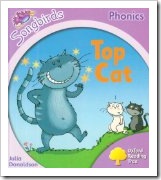Learning to read

This afternoon, I spent 5 minutes or so making a new word flip book for Rosemary, using a Post-it pad. She’s been doing very well with the flip book I made a few weeks ago and that we’ve been adding to, which started off just with the first letters they learnt at school (SATP) then added in new letters (IN) and soon some short words. We added more letters over half-term, as she had wanted to go ahead, and a few more words. But the last couple of days she’s started making jokes about it – pretending an S is an N and the like. And it occurred to me that she was getting fed up of just doing the letters. I asked her if this was the case and she confirmed it was.
She’s been blending for about three weeks now and can now do so without sounding the letters out loud (though she does sometimes feel the need to put her hand over her mouth or ask me to close my eyes) and I figured she really needed a bit more. So I wrote down all the letters that she knows (with the Jolly Phonics actions – she knows some other letters in different ways) and wrote down a bunch of words and even some sentences using these letters.
And then I thought that maybe I should see if I could come up with a story of some kind and perhaps I could illustrate it and wouldn’t that be great? (And, you know, I have so much spare time that this would be the best thing to do, of course.) Luckily, I hadn’t quite got round to it, when she got back from school. Because, in her book bag, I discovered a… wait for it… proper reading book. With words. For her to read. I did actually let out a ‘Squee!’ As a devourer of books who wishes for a lottery win mostly so she can spend more time reading, seeing my daughter on the brink of a lifelong reading journey is actually giving me butterflies.
And, considering how few letters they can use, it’s a pretty darned good book. Unsurprisingly, because it’s written by Julia Donaldson who is one of my favourite children’s authors – and, no, not just because of The Gruffalo; my favourite is probably Charlie Cook’s Favourite Book. She’d already read it at school (the teacher sounded out the letters and she blended them – so a bit below what she can actually do), so initially we had to negotiate the problem of her extremely good memory (inherited from her father as you would probably guess if you know me at all) and just saying the words that she remembered, but once I got through to her that sounding out the letters and putting them together would make words and that those words would tell the story, she was happy and enthusiastic to try – and read two pages easily. She could certainly have read more, but she was desperate for her bedtime fix of Horrid Henry.
We shall be reading it again in the morning, and having a look at my flip book, too. The breakfast table seems to be the ideal place for this kind of practising. And, you never know, maybe Eleanor will pick it up too – at the very least, it tends to keep her amused for a bit longer than the actual breakfast lasts.
Would you like to tell me about how your children found learning to read? Did they do it all at school, were they reading before they got there? Did phonics work for them, or did they need other methods? Were you as excited as I was when you saw it suddenly coming together?

Leave a Reply